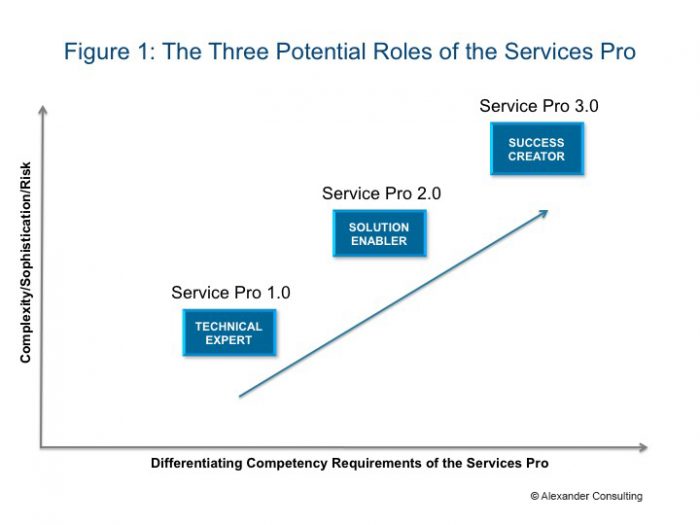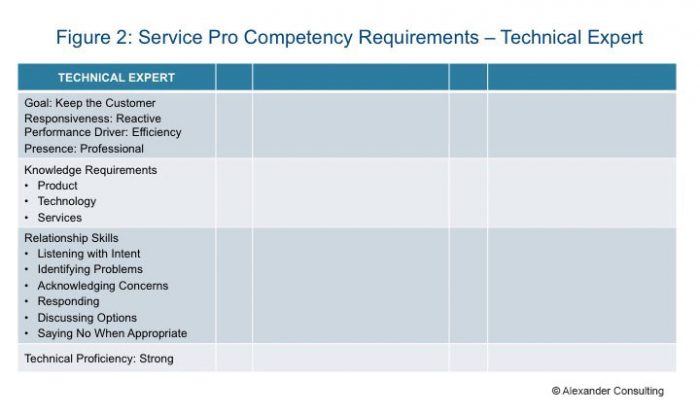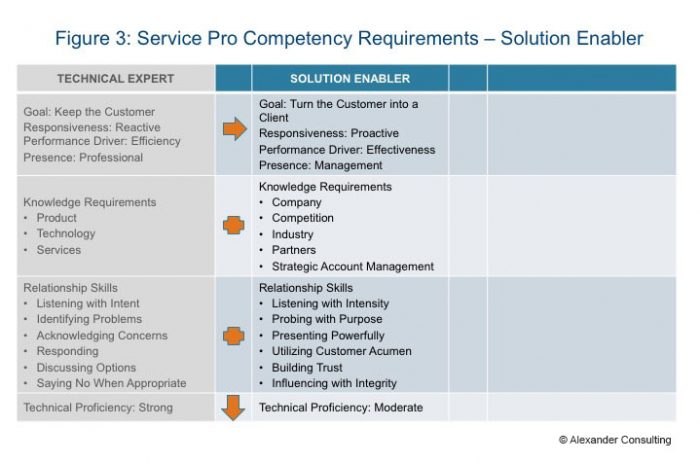Once upon a time…suppliers worshipped their products above all else.
Every day…sellers pushed their boxes and gave away services to get the deal.
One day…the buyers’ world got more complex, sophisticated, and risky.
Because of that…buyers re-prioritized the value in what they bought.
Because of that…services were elevated in importance.
Until finally…service pros became the prime creators of value—the new corporate rock stars.
Supplier Impact
Solution complexity, buyer sophistication, and perceived higher customer risk are driving new requirements of suppliers to deliver on changing expectations. Some may still emphasize products, most now focus on broader solutions, and the innovative are now targeting strategic customer success. In an earlier article, “Seriously Selling Success: The Evolution of Influence,” I outlined the profound changes required for the sales professional to successfully meet the dramatic challenges facing buying organizations.
The Elevation of Services
Services organizations face a similar challenge as their sales brethren in the need for adjusting and adapting to new customer dynamics. This article is targeted at services leaders that manage the services pros that own the customer after the initial sale has been completed. Figure 1 displays the three potential roles of the services pro based upon the customer’s level of complexity, sophistication, and perceived risk of buying/implementing supplier offerings.

I will describe, and then compare and contrast, the key competencies required for servicers within each of the three roles, emphasizing that most services organizations must elevate their performance competencies to better address the issues, needs, and expectations of their most important accounts.
However, one constant holds true for any and all services pros in any and all situations—the need to provide easy, hassle-free, brilliant customer experiences at each and every touchpoint.
Services Pro 1.0: The Technical Expert
For decades, the accepted icon of the services professional (at least in the B2B world) has been the technical expert, the image most people think of when they hear the word “service pro” (Figure 2).

Goal: Keep the Customer
Job 1 for the technical expert is to keep the customer as a customer—making sure the product sold is implemented or installed correctly, used appropriately, and then kept up and running.
Even if the product is not the best fit for the customer, even if the customer’s expectations stray from reality, it is the technical expert’s task to make things work. He uses his vast technical knowledge along with duct tape, baling wire, and eye of newt to conjure up results.
Having the customer be satisfied is nice, but not necessary. The customer needs to be just not disgruntled/disappointed enough to switch products. As long as the customer pays his bills within 90 days and doesn’t complain too loudly, all is acceptable to the supplier.
Responsiveness: Reactive
The technical expert is highly reactive to customers, to sales, and to his management. Like a fireman hearing the chiming of the bell, the technical expert leaps into action to fix the product when broken, and fix it fast.
Performance Driver: Efficiency
The high-performing technical expert often has to juggle many balls at the same time—new issues occurring at random, ongoing problem escalations, coordinating PMs, and handling special requests from management and sales. So, he strives to be efficient, setting priorities and getting his work done quickly. Hence, personal time management is key to performance.
Presence: Professional
The technical expert takes pride in his role and strives to look, speak, and act like the professional technologist he is. He is politically aware, polite to everyone, especially those not fluent in technology.
Knowledge Requirements
As his name implies, for the technical expert to perform his role, he needs a deep understanding of his products and the technology embedded in them, his company’s servicing guidelines, and when, where, and how they should be deployed.
Relationship Skills
Effective technical experts listen intently and ask appropriate questions to identify issues and solve problems. They are good at empathizing with the customer, acknowledging concerns, responding to questions, and providing updates. They communicate options to solve the problem faced, and importantly, they know when to say no, both internally and externally. The best technical experts communicate their value by explaining what they did, why they did it, and the benefit to the customer
Technical Proficiency: Strong
Combining knowledge and skills with experience, the technical expert has strong technical proficiency. He is well armed with product features and functionality and has a strong understanding of the technology built into his products and his competitors’ products. He can handle most troubleshooting himself and not bother other internal experts.
Transitioning from Technical Expert to Solution Enabler
Becoming a successful technical expert takes lots of training, homework, and years of experience. I admire those who have made this journey. In some industries it is still appropriate for the technical expert to act as the customer’s primary contact after the initial deal has been sold. In most other industries, though, for the technical expert to survive, he must evolve into a “solution enabler.”
The good news is that my experience has been that providing appropriate soft-skills training, adding minor changes to expectations, tweaking compensation, and with management coaching, about 80% of technical experts can be operating as solution enablers within six months. My book, Seriously Selling Services, provides the leadership and management requirements to make this change. Another of my books, The Brilliant Service Professional, provides the nuts-and-bolts specific changes in capabilities required of frontline services pros outlined in the next section, Services Pro. 2.0.
Let’s now compare the technical expert to the solution enabler, as shown in Figure 3.

Services Pro 2.0: Solution Enabler
As a supplier organization moves up the value chain going beyond just pushing products to providing solutions (combinations of products and various services [e.g., professional services, services contracts, training, etc.]), the service pro who owns the account must take on a new role and additional capabilities.
Goal: Turn the Customer into a Client
The goal of the solution enabler is to turn the customer into a client. Customers buy once, but clients are behaviorally loyal, in that they buy again and again. Repeat purchases are a key factor in supplier profitability, as once the cost of acquisition has been surpassed, new revenue is profitable revenue. With high degrees of satisfaction, the account is open to trying new offerings, kerchunking new streams of profitable revenue like multiple garden hoses filling a swimming pool.
Responsiveness: Proactive
Just like the technical expert, the solution enabler reacts to problems quickly. However, when customer fires are not burning, the solution enabler is proactive, actively exploring opportunities to help the customer perform better, or faster, or cheaper. He thinks through possibilities that the customer has not considered and recommends them for consideration.
Furthermore, the solution enabler is also proactive within his organization—instead of whining about some sellers selling the wrong solutions, he reaches out to sales and may get involved in presales activities with important prospects to help shape the rules of engagement. Without being asked, he shares suggestions to marketing and management to improve offerings, and the performance of the customer and his organization.
Performance Driver: Effectiveness
Of course the solution enabler wants to be efficient in his use of time, but he realizes it is more important to be effective—focusing on doing the right things. He adds value by understanding and aligning with the customer’s desired business outcomes, e.g., increasing sales, improving uptime, reducing risk, enhancing quality, or lowering costs, and then prioritizes actions to deliver results. He separates the useful many from the vital few.
Solutions often contain many moving parts with multiple projects requiring several people to do several, varying tasks in sequence and in tandem. Like a juggler in a circus, he keeps multiple plates spinning and not crashing to the floor. Hence, it is up to the solution enabler to plan, monitor, measure, and adjust the solution projects concerning quality, time, and budget. He also has a need for speed, continually focusing on compressing the time-to-value cycle his customers demand.
Presence: Management
Solutions usually cross multiple functions and geographies, and the size of the investment and the perceived possible risk usually mean that many customer functional managers and country directors are involved in decisions and impacted by results. Hence, the successful solution enabler needs credibility among all these management players—to be seen as a peer. How he looks, how he talks, and how he walks all impact his presence, and thus his credibility.
Knowledge Requirements
In addition to the requirements of the technical expert, the solution enabler can articulate the features and benefits of all his company’s offerings, such as consulting, training, or support contracts. Depending upon his company, he can articulate the plusses and minuses of solution options, such as a traditional purchase versus pay-for-usage versus pay-for-performance, or buying versus leasing, or self-servicing versus purchasing a services contract. He knows the strengths and weaknesses of his company’s partners and their employees and under which situations to involve them. He understands the various technologies to be addressed in solutions and follows the principles of strategic account management to investigate, analyze, plan, and implement an appropriate course of action that will deliver business outcomes.
Relationship Skills
In addition to the core skills outlined under the technical expert, the solution enabler must add more arrows to the relationship quiver. First, he not only listens intently, he listens with intensity to uncover both the facts and the feelings behind them. He probes with purpose to gain the information he needs to see the big picture. He presents his ideas powerfully to help initiate the customer’s willingness to change. He uses his deep customer acumen to hone the best ideas and present them tailored to the customer’s unique situation. He implements specific actions designed to gain trust quickly with key customer personnel. In all actions he takes, both inside and outside, he influences with integrity trying to do the right thing for his customer and his company.
Technical Proficiency: Moderate
The solution enabler only needs to talk technology at a high level. He lets his technical experts on the solutions team handle the in-the-weeds conversations.
Transitioning from Solution Enabler to Success Creator
Effective solution enablers add lots of value to their accounts and to their company. For many suppliers, the Services Pro 2.0, as defined above, is the appropriate role. However, as complexity, sophistication, and risk continue to rise like bread dough in a hot oven, in order to prosper, more and more organizations will have to transform the services pro to the next level of performance.
The good news is that the new capabilities required are defined, gleaned from the very best in the fields of management consulting, global account management, and social science.
Let’s now compare the solution enabler to the success creator, as shown in Figure 4.

Services Pro 3.0: Success Creator
When results have far-reaching implications, the customer decision-making elevator opens at the top floor. Yes, managers, directors, and subject-matter experts still act as key players, but client executives take an active role.
Goal: Turn the Client into a Champion
As stated earlier, clients are behaviorally loyal. When success creators excel, those clients become champions that are not only behaviorally but also attitudinally loyal. These devoted followers actively and assertively sing the praises of the success creator and his organization. They will go out of their way to introduce the success creator to their colleagues at conferences, without prompting. They will pen accolades on LinkedIn, they will gladly agree to hosting your organization’s prospects at their facility, and on and on. Champions are the drivers of your brand and a key component of generating new customers and new clients.
Like the solution consultant, the success creator vigorously pursues the delivery of outcomes, measurable returns on investment that advance the customer’s strategic initiatives. However, he takes it one step further. He understands that the key players involved in decision making, of course, want quantifiable results, but they also view decision making through the lens of what’s in it for them. The success creator demonstrates the personal wins to executives who may have widely disparate goals and agendas. Contrary to the tactical approach taken by many customer success authors, my book, Brilliant Customer Success, illuminates that customer success is both strategic and personal, providing both business outcomes and personal wins.
Responsiveness: Predictive
Like Merlin counseling King Arthur, the success creator builds upon his deep knowledge and past experience to predict the obstacles, opportunities, and outcomes the prospect will face when considering change. This predictive competency helps the success creator compress the prospect’s learning curve, outlining gaps, sharing probable risks, and generating new ways of thinking.
Performance Driver: Innovation
Dramatic change that provides the prospect the opportunity of competitive advantage goes beyond doing the tried-and-true better. Value creation relies on innovation. Therefore, the success creator ignores his industry’s best practices and uses creativity to transport fresh concepts and novel ideas being deployed in other fields and other industries.
Presence: Executive
Executives prefer not to deal directly with service people or sellers or most consultants. They prefer to deal with peers. Credentials only go so far. The success creator must ooze integrity, and look, act, walk, and talk like someone worthy and credible in the executive suite. The success creator is not only politically savvy, but culturally attuned. He understands the client’s philosophy and how that manifests itself in his client’s culture. This understanding builds credibility, likeability, and tolerance to different ideas. Like the early digital thinkers in an analog world, the success creator creates value by challenging, reframing, and disrupting accepted issues, standard models, and the status quo. He is respectful, but openly assumes the role of contrarian when facing tired ideas or business-as-usual patterns of thought.
Knowledge Requirements
Building upon the knowledge of the solution enabler, the success creator adds in the capabilities of a business executive, an organization strategist, a management consultant, and a human performance technologist. He understands how executives analyze problems and make decisions, and he understands systems thinking and its implications. Most importantly, he embraces the concept that value creation and innovation require change, and sometimes dramatic transformation, to be successful.
Relationship Skills
Orchestrating the Team: The technical expert can be effective with limited support, and the solution enabler needs just a few experts at the ready. Because of the width and depth of the challenge, the success creator needs a team inside and often a team within the prospect to achieve mutual goals. Hence, he orchestrates, coordinates, delegates responsibilities, monitors performance, and adjusts, as needed, to do the right things the right way at the right time.
Collaborative Contracting: Contracting goes beyond the Ts and Cs of a formal business contract to establish a personal agreement between the success creator and key players within the account. This one-on-one and face-to-face session “defines the playing field,” covering responsibilities, expectations, probable issues, and ways to deal with them. The emphasis is on discussing personal wins and how to achieve them. This activity pours a solid foundation for jointly building new ideas that may challenge the status quo.
Predicting with Power: Predicting is the responsiveness method employed by the success creator. Predicting is a sophisticated influencing skill implemented by highly experienced success creators. It uses scenario planning and, occasionally, case studies to map out probable and possible outcomes based upon current trends and intended actions. At the same time, it positions the success creator as the executive peer that he is.
Negotiating Mutual Success: Change…big ideas…innovation…all of these can forecast business vulnerabilities and personal threat. Mediating differences early helps to find and maintain common ground. Negotiating mutual success is an especially valuable skill required any time when dealing with important, sometimes controversial, ideas and people with different viewpoints. A key element of this skill set is the ability to confront with integrity and challenge ideas not based on facts.
Speaking with Pizazz: The success creator must hone his already-fluent presentation skills to speak with impact, whether leading a quarterly business review, chatting with a client in an elevator headed to the lobby, or presenting recommendations to the board. Mastery of this skill turns good speakers into powerful orators in the minds of those in the audience, be it an audience of one or thousands.
Technical Proficiency: Just Enough
Executives speak “business-ease,” so the success creator needs just enough technical acumen to broadly link his technology to the business issues at hand. He leaves all other discussions of a technical nature to his experts.
So, what should your services pros look and act like?
Do you need to lead the transformation of your frontline sales pros from technical experts to solution enablers, or from solution enablers to success creators? What are the challenges? What are the appropriate transition practices? Below are a couple of options.
Invest a Few Bucks: Initiate a Services Pro 3.0 Readiness Review to get unbiased facts to:
- Get a clear understanding of what your key accounts need, want, and expect.
- Find out how your services pros stack up against the competencies outlined in this article.
- Understand how you compare against your best competitors.
- If you need to crank up your competencies, find out how ready you are to do it.
- Learn the key actions to make the transition as quickly as your situation allows.
Or…
Go with Your Gut: Use your experience to make the call:
- Things simple and stable? The technical expert is able.
- Situation more complex? The solution enabler is best.
- High risk and high stakes? The success creator is what it takes.



